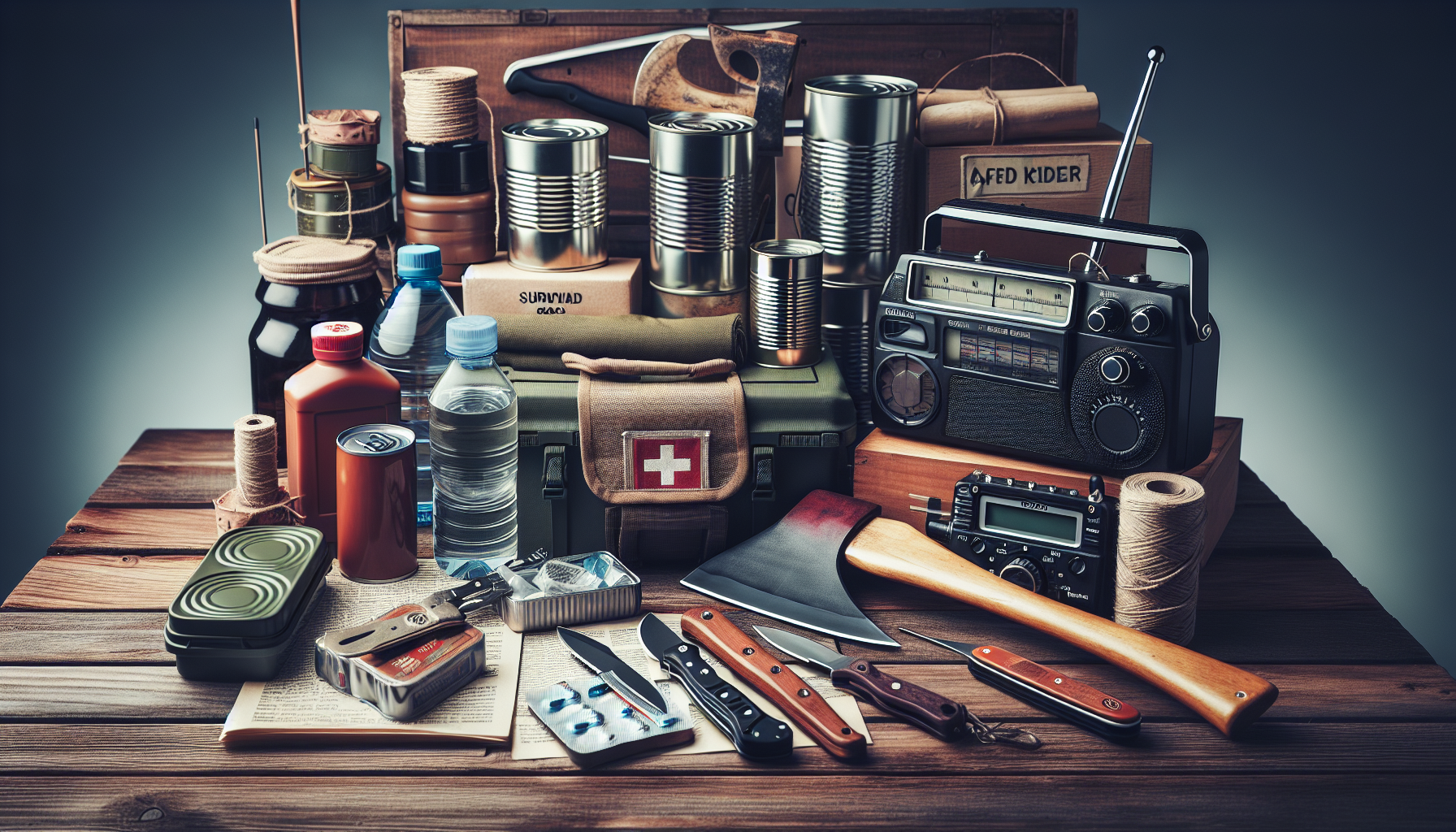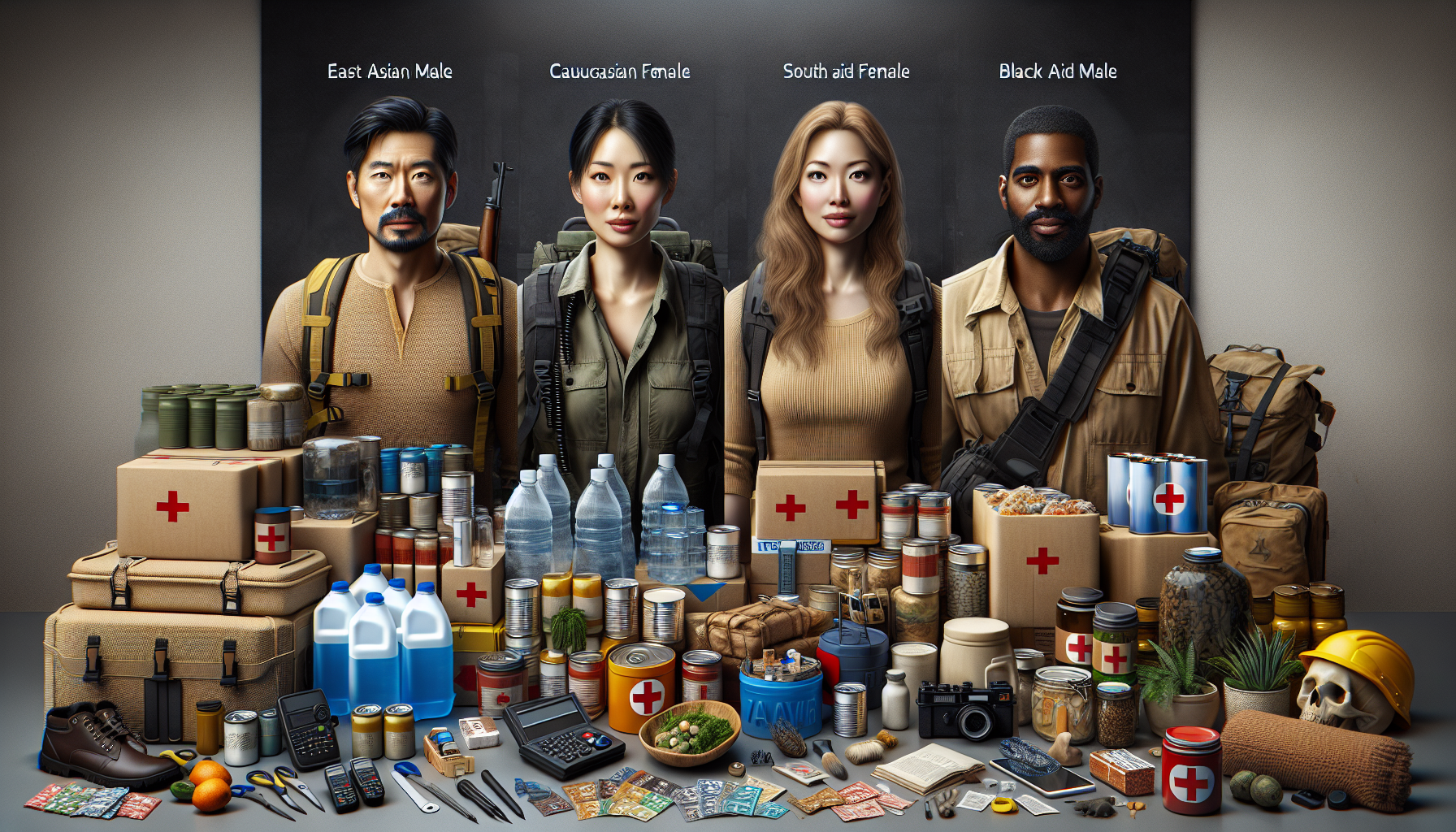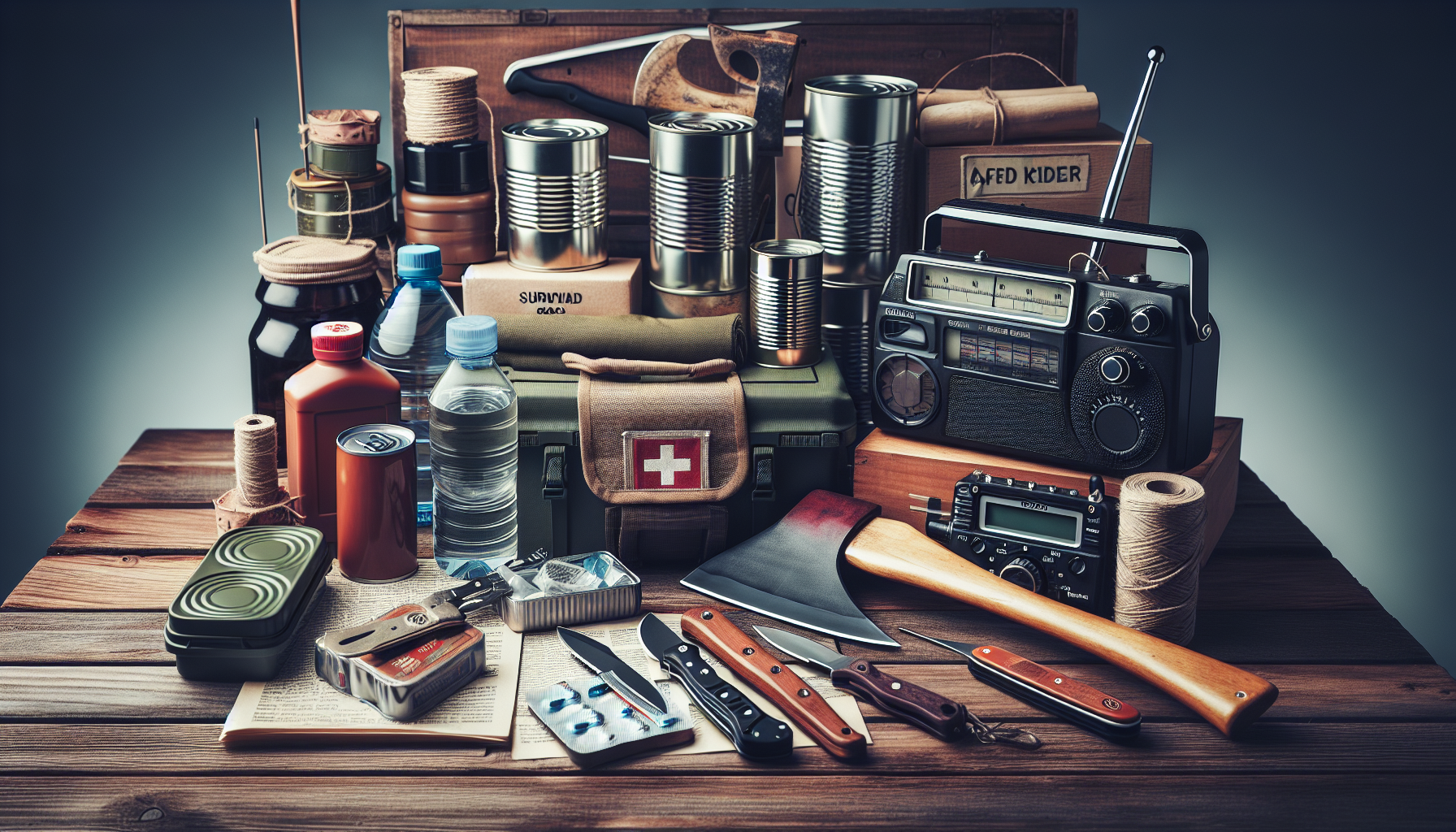Imagine a world where disaster strikes unexpectedly, leaving you and your loved ones in a potentially dangerous situation. In times like these, the answer lies in preparedness. As a prepper, it’s crucial to be equipped with the essentials that can make all the difference in such challenging times. From non-perishable foods to clean drinking water, medical supplies to secure shelter, the key lies in carefully curating a stockpile that can sustain you through any unforeseen event. In this article, we will explore the top items that you, as a prepper, should prioritize in your stockpile, ensuring that you are ready for whatever comes your way.

Food and Water
When it comes to emergency preparedness, one of the most important considerations is ensuring you have an ample supply of food and water. In times of crisis or disaster, access to fresh food and clean water may be limited or even cut off entirely. That’s why it’s crucial to have a stockpile of non-perishable food items and a reliable means of water storage and purification.
Non-perishable food items
Stocking up on non-perishable food items is essential. These are foods that have a long shelf life and do not require refrigeration. Some excellent options to consider are canned goods, dehydrated or freeze-dried meals, and meal bars. Be sure to rotate your stockpile regularly to ensure freshness, and remember to include a manual can opener as well.
Water storage and purification
Having a sufficient supply of clean drinking water is vital for survival. It’s recommended to store at least one gallon of water per person per day for a minimum of three days. Utilize food-grade containers and keep them in a cool, dark place away from direct sunlight. Additionally, invest in water purification methods such as water filters, purification tablets, or boiling water to ensure your water supply remains safe and uncontaminated.
Canned goods
Canned goods are a convenient and reliable food option during emergencies. They have a long shelf life and are packed with essential nutrients. Consider stocking up on canned vegetables, fruits, beans, and proteins such as tuna or chicken. These versatile items can be consumed straight from the can or easily incorporated into meals.
Long shelf-life foods
In addition to canned goods, it’s wise to have a supply of long shelf-life foods. These include items like rice, pasta, oatmeal, and dried beans. These pantry staples can provide essential carbohydrates and can be combined with canned goods or other ingredients to create nutritious meals.
Bulk grains and legumes
Bulk grains and legumes are a cost-effective and sustainable way to build your emergency food stockpile. Items like wheat berries, quinoa, lentils, and chickpeas are nutrient-dense, have long shelf lives, and can be used as the foundation for a variety of meals. Consider investing in airtight containers to store these items properly.
Preservation and cooking methods
During a crisis, electricity or gas may not be readily available. It’s important to have alternative methods for food preservation and cooking. Some options include dehydrating fruits and vegetables, smoking meats, or utilizing a solar cooker. Explore different preservation and cooking techniques that align with your resources and preferences.
First Aid and Medical Supplies
A comprehensive first aid kit and necessary medical supplies are essential in times of emergency. Whether you’re dealing with minor injuries or more severe medical conditions, being prepared can make all the difference in your ability to provide care and support.
Basic first aid kit
Every prepper should have a well-stocked first aid kit. Include items such as bandages, gauze pads, adhesive tape, antiseptic wipes, scissors, tweezers, and disposable gloves. Additionally, include any personal medications or prescriptions that you and your family require.
Medications and prescriptions
If you or your family members rely on specific medications or prescriptions, it’s critical to have an adequate supply on hand. Speak with your healthcare provider about obtaining a 30-day emergency prescription, and regularly rotate your supply to ensure freshness. Consider investing in a pill organizer to keep medications organized and easily accessible.
Sanitation and hygiene supplies
Maintaining proper sanitation and hygiene is crucial to prevent the spread of disease and infection. Stock up on items such as hand sanitizer, soap, toilet paper, menstrual supplies, and diapers (if necessary). Additionally, include personal hygiene items like toothbrushes, toothpaste, and feminine hygiene products.
Emergency medical equipment
Depending on your level of preparedness, you may want to consider adding emergency medical equipment to your supplies. These could include items such as a blood pressure monitor, stethoscope, sutures, splints, or a portable defibrillator. However, keep in mind that proficiency in using these items is essential, so it may be beneficial to undergo training or consult a medical professional before incorporating them into your kit.
Tools and Equipment
Having the right tools and equipment can greatly enhance your ability to navigate, communicate, and perform necessary tasks during an emergency situation. These items are designed to provide practical solutions and aid in your overall preparedness.
Multi-tool
A multi-tool is an invaluable item to have in your emergency kit. These compact tools often include various functions such as pliers, screwdrivers, knives, and saws. They are ideal for performing a range of tasks, from repairing equipment to opening cans or bottles.
Portable camp stove and fuel
During an emergency, having a portable camp stove and a supply of fuel can ensure you have a reliable means of cooking and heating water. Look for lightweight, compact stoves that use propane or butane canisters. These can provide a source of warmth and allow you to prepare warm meals when traditional methods are not available.
Flashlights and batteries
A reliable source of light is essential during emergencies, particularly if power outages occur. Invest in high-quality flashlights and a supply of batteries. Consider having multiple flashlights stored in different locations for easy access.
Hand crank radio
Staying informed during an emergency is crucial. A hand crank radio allows you to access important updates, news, and weather information even when regular communication channels are down. Look for models with additional features like a built-in flashlight or USB charging port.
Firestarter and matches
Fire can provide warmth, light, and the ability to cook food. Be sure to have firestarters, such as waterproof matches or a ferro rod, in your emergency supplies. These reliable ignition sources can help you start a fire even in challenging conditions.
Survival knife
A survival knife is a versatile tool that can be used for various purposes, such as cutting rope, opening cans, or even self-defense if needed. Choose a knife with a sturdy blade, ergonomic handle, and a sheath for safe storage.
Communication and Navigation
Situational awareness is vital during emergencies, and having the means to communicate and navigate can greatly enhance your level of preparedness. These items can help you stay connected with loved ones, send distress signals, and find your way to safety.
Two-way radios
Two-way radios are an excellent communication tool when cell phone networks may be unreliable or unavailable. These radios allow you to maintain contact with family members or other individuals in your group, providing a reliable means of communication over short distances.
Personal locator beacon
In extreme situations where you may require rescuing, a personal locator beacon (PLB) can be a lifesaver. These devices emit a distress signal that can be detected by search and rescue teams, enabling them to locate you quickly.
Compass and maps
Having a compass and maps of your area is essential for navigation. A compass can help you determine the cardinal directions, while maps can provide valuable information about nearby resources, potential hazards, and alternative routes.
Whistle and signal mirror
In situations where you need to attract attention or signal for help, a whistle and signal mirror can be highly effective. A loud whistle can carry over long distances, while a signal mirror can reflect sunlight and catch the attention of rescue teams or passing aircraft.

Clothing and Bedding
Proper clothing and bedding are vital for staying comfortable and protected during emergencies, especially in unpredictable weather conditions. Ensuring you have the necessary items can help prevent exposure-related illnesses and ensure a good night’s rest.
Sturdy shoes and boots
Having sturdy shoes or boots is essential for navigating through various terrains and protecting your feet from potential injuries. Look for footwear that is durable, waterproof, and provides good ankle support. Break-in any new footwear before an emergency situation arises to avoid discomfort or blisters.
Weather-appropriate clothing
Depending on your location and climate, it’s crucial to have weather-appropriate clothing readily available. This includes items such as jackets, hats, gloves, and thermal layers to protect against extreme temperatures, rain, or snow. Remember to consider the specific needs of family members, including infants, children, or the elderly.
Sleeping bags and blankets
Having warm and comfortable sleeping bags or blankets is essential for a good night’s rest, regardless of the environment. Look for insulation ratings appropriate for your climate and consider having additional blankets or sleeping bags for family members or guests.
Extra socks and underwear
It’s often said that keeping your feet dry is one of the keys to survival. Ensure you have extra pairs of socks and underwear in your emergency supplies. These items can provide comfort and help prevent issues such as blisters or infections.
Shelter and Warmth
During emergencies, having a reliable shelter and appropriate means of staying warm and protected from the elements is crucial for your survival and well-being. Be prepared to create temporary shelter or fortify existing structures if necessary.
Tents or tarps
Tents or tarps can provide essential shelter in various scenarios. Look for lightweight, easy-to-assemble options that provide protection against rain, wind, and insects. Familiarize yourself with the setup process beforehand, and consider practicing setting up the tent or tarp at home to ensure you can do so quickly and efficiently during an emergency.
Sleeping pads or mats
Sleeping pads or mats can greatly improve comfort and insulation when sleeping on the ground or in a makeshift shelter. These lightweight and compact items provide a barrier between you and the cold or uneven terrain.
Insulated clothing and blankets
In colder climates or during winter months, having insulated clothing and blankets is crucial. Look for options that provide good insulation and are moisture-wicking to help regulate body temperature. Insulated blankets or emergency sleeping bags can also be used to retain body heat in cold environments.
Emergency shelter kits
Consider investing in emergency shelter kits that include items like emergency blankets, ponchos, rope, and duct tape. These kits can provide additional resources for creating temporary shelters, sealing off areas from the elements, or fortifying existing structures.
Self-Defense and Security
While it’s essential to prioritize personal safety during emergencies, having means of self-defense and security can provide peace of mind and protection for you and your loved ones.
Personal protection devices
There is a range of personal protection devices available on the market, including items such as personal alarms, stun guns, or tactical pens. Carefully research and familiarize yourself with local laws and regulations regarding the use and possession of these devices.
Pepper spray or mace
Pepper spray or mace can serve as a non-lethal self-defense option. These items are compact and easily carried, providing a means of temporarily incapacitating an attacker. Ensure that you are familiar with the proper use of these products and keep them easily accessible in case of an emergency.
Firearms and ammunition
If you choose to include firearms as part of your emergency preparedness plan, it’s crucial to prioritize safety and adhere to local laws and regulations. Proper training, secure storage, and responsible ownership are imperative aspects of firearm preparedness.
Home security measures
In addition to personal self-defense, considering home security measures is essential. This may include reinforcing doors and windows, installing outdoor lighting, or utilizing security systems. Regularly assess the security of your home and make any necessary enhancements to ensure the safety of yourself and your family.
Personal Documents and Cash
Having essential personal documents and cash readily available can greatly expedite recovery and help you regain normalcy after an emergency. These documents and funds are crucial for identification, insurance claims, and other administrative tasks.
Identification documents
Ensure you have copies of all essential identification documents stored in a secure, waterproof container. This may include passports, birth certificates, driver’s licenses, Social Security cards, and any other important personal identification. Additionally, consider having digital copies stored securely online or on a portable storage device.
Important records
In addition to identification documents, it’s vital to have copies of other essential records. This may include insurance policies, medical records, property deeds, wills, and financial documents. Storing these documents in a secure and easily accessible location will save you time and hassle during the recovery process.
Cash in small denominations
During emergencies, access to banks or electronic payment systems may be limited or non-existent. It’s wise to have a stash of cash in small denominations. This can help you purchase necessary supplies or services when traditional payment methods are not available.
Power and Energy
Being able to generate and store power can greatly enhance your level of preparedness, allowing you to maintain essential communication, power electronic devices, or provide basic comfort during prolonged outages.
Solar panels and chargers
Consider investing in solar panels and chargers to harness the power of the sun. These can be used to charge small devices like cell phones, rechargeable batteries, or power banks. Portable and foldable solar panels are available, making them an excellent option for emergency situations.
Power banks
Power banks are portable battery packs that store electrical energy, which can be used to charge electronic devices. Invest in high-capacity power banks to ensure you have enough energy to keep essential devices functioning during power outages.
Portable generators
Portable generators are valuable assets in emergencies, providing a reliable source of power for a wide range of devices. When selecting a generator, consider its capacity, fuel requirements, and safety features. Familiarize yourself with proper usage, maintenance, and safety precautions before operating a generator.
Battery-powered devices
Having battery-powered devices is essential when it comes to emergency preparedness. Flashlights, radios, fans, and other essential devices should all have a supply of batteries readily available. Consider investing in rechargeable batteries and a solar-powered battery charger to minimize waste and ensure a constant power source.
Entertainment and Mental Health
During times of crisis and uncertainty, maintaining mental health and providing outlets for relaxation and diversion is crucial. Here are some items to consider when it comes to entertainment and mental well-being.
Books and games
Books and games can provide much-needed diversion and entertainment during stressful situations. Stock up on books that you enjoy reading or have a collection of board games or card games that can be played with family or friends. These activities can help reduce stress and maintain a sense of normalcy.
Art supplies
For those who find solace in creativity, having art supplies readily available can be beneficial for mental well-being. Consider having items like sketchbooks, coloring books, colored pencils, or paints on hand. Engaging in artistic activities can help alleviate stress and provide a sense of relaxation.
Stress relief tools
Consider including stress relief tools in your emergency supplies. These may include items such as stress balls, fidget spinners, or meditation aids. Utilizing these tools can help ease anxiety and provide a sense of calm during challenging situations.
Emotional support resources
During emergencies, it’s essential to prioritize emotional well-being. It’s valuable to have resources available to address emotional needs and provide support. This could include contact information for mental health professionals, helplines, or support groups. Familiarize yourself and your loved ones with these resources before an emergency occurs.
In conclusion, being prepared for emergencies requires attention to various aspects of survival and well-being. By stocking up on essential food and water supplies, first aid and medical equipment, tools and equipment, communication and navigation devices, clothing and bedding, shelter and warmth items, self-defense and security measures, personal documents and cash, power and energy solutions, and entertainment and mental health resources, you can ensure your readiness for unexpected situations. Remember to regularly assess and update your emergency supplies and remain vigilant in maintaining your preparedness. Stay safe, be proactive, and prioritize the well-being of yourself and your loved ones.
